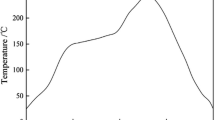Abstract
In the present study, addition of TiO2 nanoparticles with a concentration in the range from 0 to 0.75 wt% into eutectic Sn3.0Ag0.5Cu solders were prepared. The effect of TiO2 addition concentration on intermetallic compounds (IMC) growth in solder matrix, wettability of the composite solder, and interfacial IMC growth at composite solder/Cu interface were studied respectively. The microstructure images show that both IMC growth in solder matrix and interfacial IMC growth at solder/Cu interface were suppressed when TiO2 nanoparticles are added into the Sn3.0Ag0.5Cu solder system, meanwhile, wettability test results show wetting time reduction and wetting force enlargement with TiO2 nanoparticles addition concentration increasing. These results reveal that the added TiO2 nanoparticles in solders work as reinforce agent and enhance solder performance by reducing IMC dimension and improving wettability. However, TiO2 addition concentration is critical to the improvement extent. The matrix IMC size and interfacial IMC thickness were reduced significantly with the TiO2 addition concentration increasing in small addition range (0, 0.1 and 0.25 wt%). The most significant suppression appears when TiO2 concentration is about 0.25 wt%. Beyond this concentration, the matrix IMC size and interfacial IMC thickness increase, but still smaller than non-added Sn3.0Ag0.5Cu solder. Sn–Ag–Cu (SAC)–0.25TiO2 exhibits most obviously refined solder microstructure. The variation of wetting time and wetting force with the change of TiO2 concentration are similar. Addition of 0.25 wt% TiO2 shortens wetting time and strengthens wetting force most effectively. SAC–0.25TiO2 exhibit best wettability performance as well. The IMC variation consistent with wettability variation revels there is an optimal TiO2 addition concentration which is about 0.25 wt%. Both insufficient adding and excessive adding will weaken the TiO2 nanoparticle reinforcement extent. Based on the theory of adsorption and agglomeration, a mechanism of the TiO2 nanoparticle concentration effect and the optimal addition point was proposed.










Similar content being viewed by others
References
M. Abtew, G. Selvaduray, Mater. Sci. Eng. R Rep. 27, 95–141 (2000)
K.N. Tu, Solder Joint Technology: Materials, Properties, and Reliability (Springer, New York, 2007)
N. Chawla, Int. Mater. Rev. 54, 368–384 (2009)
B.Y. Wu, Y.C. Chan, A. Middendorf, X. Gu, H.W. Zhong, J. Environ. Sci. 20, 1403–1408 (2008)
K. Zeng, K.N. Tu, Mater. Sci. Eng. R Rep. 38, 55–105 (2002)
C.Y. Lin, U.S. Mohanty, J.H. Chou, J. Alloy Compd. 501, 204–210 (2010)
L.R. Garcia, W.R. Osorio, L.C. Peixoto, A. Garcia, J. Electron. Mater. 38, 2405–2414 (2009)
G. Zeng, S. Xue, L. Zhang, L. Gao, W. Dai, J. Luo, J. Mater. Sci. Mater. Electron. 21, 421–440 (2010)
F.X. Che, J.H.L. Pang, J. Alloy. Compd. 541, 6–13 (2012)
L.C. Tsao, Mater. Sci. Eng. A 529, 41–48 (2011)
T. Fouzder, I. Shafiq, Y.C. Chan, A. Sharif, W.K.C. Yung, J. Alloy Compd. 509, 1885–1892 (2011)
K. Kanlayasiri, M. Mongkolwongrojn, T. Ariga, J. Alloy Compd. 485, 225–230 (2009)
W. Xiao, Y. Shi, G. Xu et al., J. Alloy Compd. 472, 198–202 (2009)
Y.C. Chan, D. Yang, Prog. Mater. Sci. 55, 428–475 (2010)
A.S.M.A. Haseeb, T.S. Leng, Intermetallics 19, 707–712 (2011)
S.L. Tay, A.S.M.A. Haseeb, J. Mohd, Rafie. Solder. Surf. Mater. Technol. 23, 10–14 (2011)
A.K. Gain, Y.C. Chan, W.K.C. Yung, Microelectron. Reliab. 51, 2306–2313 (2011)
J.X. Wang, S.B. Xue, Z.J. Han et al., J. Alloy Compd. 467, 219–226 (2009)
L. Zhang, J.G. Han, C.W. He, Y.H. Guo, J. Mater. Sci. Mater. Electron. 23, 1950–1956 (2012)
X.D. Liu, Y.D. Han, H.Y. Jing, J. Wei, L.Y. Xu, Mater. Sci. Eng. A 562, 25–32 (2013)
A.K. Gain, Y.C. Chan, W.K.C. Yung, Microelectron. Reliab. 51, 975–984 (2011)
S.Y. Chang, C.C. Jain, T.H. Chuang, L.P. Feng, L.C. Tsao, Mater. Des. 32, 4720–4727 (2011)
J.C. Leong, L.C. Tsao, C.J. Fang, C.P. Chu, J. Mater. Sci. Mater. Electron. 22, 1443–1449 (2011)
L.C. Tsao, M.W. Wu, S.Y. Chang, J. Mater. Sci. Mater. Electron. 23, 681–687 (2012)
Y. Tang, G.Y. Li, Y.C. Pan, J. Alloy Compd. 554, 195–203 (2013)
L.C. Tsao, C.P. Chu, S.F. Peng, Microelectron. Eng. 88, 2964–2969 (2011)
L.C. Tsao, C.H. Huang, C.H. Chung, R.S. Chen, Mater. Sci. Eng. A 545, 194–200 (2012)
W.D. Callister, D.G. Rethwisch, Fundamentals of Materials Science and Engineering: An Integrated Approach (Wiley, New York, 2004)
A.K. Gain, T. Fouzder, Y.C. Chan, A. Sharif, W.K.C. Yung, J. Alloy Compd. 489, 678–684 (2010)
Y. Tang, G.Y. Li, Y.C. Pan, Mater. Des. 55, 574–582 (2014)
J. Shen, Y.C. Chan, Microelectron. Reliab. 49, 223–234 (2009)
L.C. Tsao, J. Alloy Compd. 509, 8441–8448 (2011)
D.Q. Yu, L. Wang, C.M.L. Wu, C.M.T. Law, J. Alloy Compd. 389, 153–158 (2005)
D.Q. Yu, C.M.L. Wu, C.M.T. Law, L. Wang, J.K.L. Lai, J. Alloy Compd. 392, 192–199 (2005)
X. Liu, M. Huang, Y. Zhao, C.M.L. Wu, L. Wang, J. Alloy Compd. 492, 433–438 (2010)
M. Amagai, Microelectron. Reliab. 48, 1–16 (2008)
K.K. Nanda, A. Maisels, F.E. Kruis, H. Fissan, S. Stappert, Phys. Rev. Lett. 91, 106102 (2003)
F. Bødker, S. Mørup, S. Linderoth, Phys. Rev. Lett. 72, 282–285 (1994)
Acknowledgments
The authors gratefully acknowledge the support received from National Science and Technology Major Project (2011ZX02607).
Author information
Authors and Affiliations
Corresponding author
Rights and permissions
About this article
Cite this article
Li, Y., Zhao, X., Liu, Y. et al. Effect of TiO2 addition concentration on the wettability and intermetallic compounds growth of Sn3.0Ag0.5Cu–xTiO2 nano-composite solders. J Mater Sci: Mater Electron 25, 3816–3827 (2014). https://doi.org/10.1007/s10854-014-2094-9
Received:
Accepted:
Published:
Issue Date:
DOI: https://doi.org/10.1007/s10854-014-2094-9




